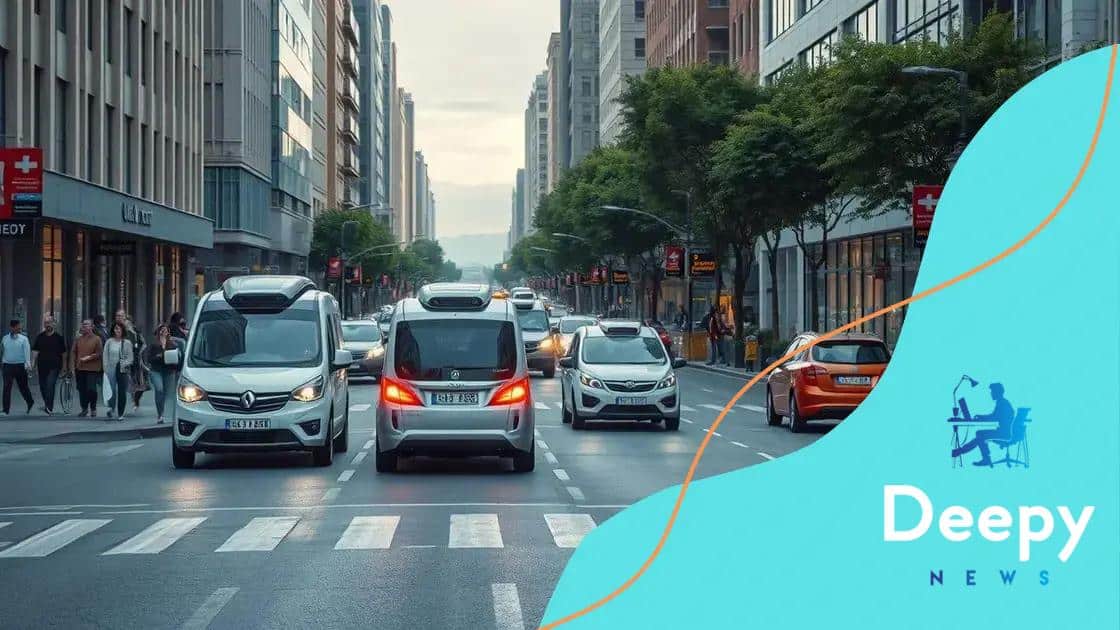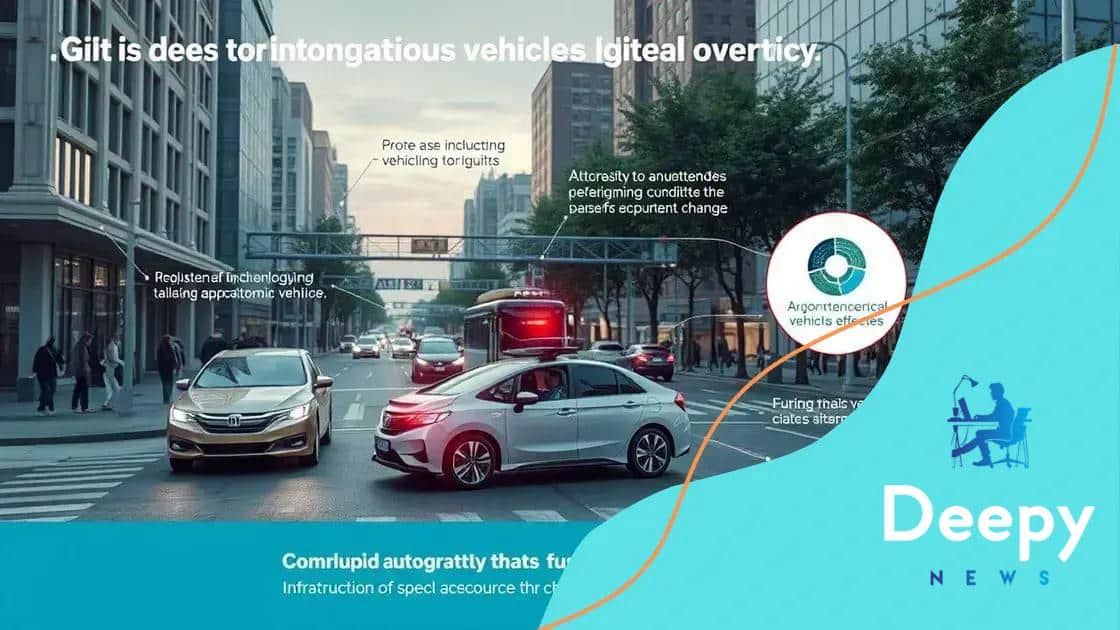How autonomous vehicles are transforming urban transport

Autonomous vehicles are transforming urban transport by improving accessibility, enhancing safety, reducing emissions, and reshaping urban planning, leading to more efficient and livable cities.
How autonomous vehicles are transforming urban transport is more than just a trend; it’s a revolution in how we navigate our cities. Have you ever wondered how these innovations affect your daily commute? Let’s dive into the details.
The technology behind autonomous vehicles
The technology behind autonomous vehicles is fascinating and complex. These vehicles rely on several key elements to operate safely and efficiently.
Key Technologies in Autonomous Vehicles
At the core of autonomous vehicles is the use of advanced sensors and software algorithms. These technologies help vehicles understand their environment and make real-time decisions. The following technologies play a crucial role:
- LiDAR: This technology uses lasers to create a 3D map of the surroundings, allowing the vehicle to detect obstacles.
- Camera Systems: Cameras provide visual data, helping vehicles recognize traffic signals, lane markings, and pedestrians.
- Radar: Radar systems detect the speed and distance of surrounding objects, which is essential for maintaining safe distances.
- Control Algorithms: These algorithms process data from sensors and make driving decisions, such as when to accelerate or brake.
By integrating these technologies, autonomous vehicles can perceive the world around them. This perception is vital for ensuring safety in complex driving conditions, such as busy city streets.
Machine Learning and AI
Another significant component is the use of machine learning and artificial intelligence. These technologies allow vehicles to learn from vast amounts of data and improve their performance over time. For example, AI algorithms analyze thousands of driving scenarios to understand how to respond appropriately to various situations. This ability to learn makes autonomous vehicles more adaptable and enhances their decision-making capabilities.
The integration of connectivity is also essential. Autonomous vehicles often communicate with each other and with traffic infrastructure. This communication helps optimize traffic flow and reduce accidents. Moreover, cloud computing enables vehicles to process data more efficiently, contributing to their overall functionality.
As these technologies continue to evolve, we can expect significant advancements in the capabilities of autonomous vehicles. They offer the potential to transform not just how we drive, but also how our cities are designed and function.
Benefits of autonomous transport for cities
The benefits of autonomous transport for cities are numerous and impactful. As these vehicles become more common, they promise to change urban life significantly.
Improved Safety
One of the most important benefits is enhanced safety on the roads. Autonomous vehicles are programmed to recognize hazards and react quickly, reducing the likelihood of accidents. Statistics show that many accidents are caused by human error. By minimizing this factor, cities can expect fewer injuries and fatalities.
Reduced Traffic Congestion
Traffic congestion is a major issue in urban areas. Autonomous vehicles can communicate with each other to optimize routes and maintain smoother traffic flow. This technology helps minimize stop-and-go situations, leading to less pollution and a better overall travel experience.
- Enhanced route planning based on real-time data.
- Fewer cars on the road due to shared autonomous transport options.
- Timely responses to traffic signals, making intersections more efficient.
Moreover, with reduced congestion, public transport can operate more effectively. This could lead to increased ridership, encouraging cities to invest more in sustainable transport options.
Environmental Benefits
Another significant advantage is the positive impact on the environment. Autonomous vehicles are often designed to be electric or more fuel-efficient. This transition can lead to a substantial decrease in greenhouse gas emissions. As cities adopt these vehicles, air quality can improve, making urban areas healthier places to live.
Additionally, fewer emissions contribute to combating climate change. By embracing this new technology, cities can take major steps toward sustainability.
As urban planners think about the future, integrating autonomous transport into city designs will play a vital role in the overall livability of urban spaces. By prioritizing these systems, cities can become more accessible, efficient, and pleasant for all residents.
Challenges in integrating autonomous vehicles

Integrating autonomous vehicles into existing urban landscapes presents multiple challenges. These difficulties stem from technology, infrastructure, and public acceptance.
Technological Limitations
While the technology behind autonomous vehicles is advanced, it’s not perfect. One significant challenge is ensuring these systems can operate effectively in diverse weather conditions. Rain, snow, and fog can hinder the effectiveness of sensors like LiDAR and cameras.
Infrastructure Needs
Additionally, the current infrastructure in many cities may not support the full capabilities of autonomous vehicles. Roads, traffic signals, and signage need to be upgraded to communicate effectively with these vehicles. Without this integration, autonomous cars may struggle to navigate safely.
- Need for smarter traffic signals that adapt in real-time.
- Upgraded road markings and signage to aid vehicle perception.
- Creation of dedicated lanes for autonomous and mixed traffic.
Moreover, building this infrastructure requires significant investment from both public and private sectors. Cities will need to collaborate with technology companies to create an ecosystem that supports the safe operation of autonomous transport.
Public acceptance also plays a crucial role in the integration of these vehicles. Many people are still skeptical about the safety and reliability of autonomous technology. Education and awareness campaigns will be vital in addressing these concerns. Demonstrating the safety benefits of these vehicles can help build trust among potential users.
As cities grapple with these challenges, it is essential to embrace innovation and adaptability. By addressing technological limitations, upgrading infrastructure, and increasing public awareness, the transition to autonomous transport can become smoother and more effective.
Impact on urban infrastructure
The impact of autonomous vehicles on urban infrastructure is significant and multifaceted. As these vehicles become more prevalent, city planners and developers must adapt infrastructure to support them.
Smart Infrastructure Development
One major consideration is the development of smart infrastructure. This includes traffic signals that can communicate with autonomous vehicles, allowing for better traffic flow and safety. By using real-time data, cities can optimize signal patterns to prevent congestion and reduce waiting times.
- Smart traffic management systems that adjust based on vehicle density.
- Infrastructure designed for vehicle-to-everything (V2X) communication.
- Enhanced road markings and signage to aid navigation.
Keeping the right infrastructure is crucial for ensuring that autonomous vehicles operate safely and efficiently. For example, dedicated lanes for autonomous vehicles can reduce conflicts with traditional traffic. By separating these vehicles from the rest of the traffic flow, cities can improve safety for both autonomous and non-autonomous vehicles.
Parking Solutions
As autonomous vehicles change travel patterns, there may also be a decline in traditional parking needs. These vehicles can drop passengers off and then park themselves in more efficient areas or drive to less congested zones. This could lead to the repurposing of parking structures into green spaces or community areas, enhancing the overall urban landscape.
With fewer vehicles needing stationary parking, cities could use this opportunity to redesign urban environments. Areas that once housed parking lots can be transformed into parks, bike lanes, or pedestrian paths, making cities more livable and enjoyable.
Moreover, maintenance costs for city infrastructure might change as autonomous vehicles emerge. With improved traffic flow and fewer accidents, the wear and tear on roads could decrease, resulting in potential savings for city budgets. This financial aspect could allow for further investment into sustainable development initiatives.
The future of transport with autonomous vehicles
The future of transport with autonomous vehicles promises exciting changes for society and urban living. As technology continues to advance, we can expect to see profound shifts in how we travel and interact with our environments.
Greater Accessibility
One significant benefit will be improved accessibility for all. Autonomous vehicles can provide reliable transportation options for individuals who may not be able to drive, such as the elderly and people with disabilities. With this increased accessibility, everyone can participate more fully in community life.
- Enhanced mobility for those with limited transportation options.
- Increased independence for the elderly.
- Opportunity for social engagement and reduced isolation.
This level of accessibility can lead to more inclusive cities where all residents can take advantage of services, employment, and social opportunities.
Environmental Sustainability
Additionally, the future of transport will likely lean towards sustainability. Many autonomous vehicles are designed to be electric, meaning they produce fewer emissions compared to traditional combustion engines. This shift can contribute to cleaner air and a reduction in greenhouse gases.
With advancements in shared mobility solutions, such as ride-sharing with autonomous vehicles, cities can also reduce the number of cars on the road. This leads to less traffic congestion and lower overall emissions. As cities adapt to this new transport model, we may see urban areas being transformed, with more green spaces and less reliance on fossil fuels.
The integration of autonomous vehicles will also foster innovation in urban planning. City designs will evolve to accommodate fewer parking spaces and prioritize pedestrian areas, bike lanes, and public transport hubs. Architects and planners will rethink spaces, creating vibrant and environmentally friendly neighborhoods.
As we move forward, understanding the potential impact of autonomous vehicles on transport can help us make informed decisions. Collaboration among governments, communities, and tech companies will be crucial to ensure a smooth transition into this new era of transportation.
The rise of autonomous vehicles is set to transform how we navigate and interact with our cities. This technology carries significant potential to improve accessibility, enhance safety, and foster environmental sustainability. The collaboration between technology developers and urban planners is essential to harness these benefits effectively. As we embrace this change, it’s vital for communities to be prepared for the innovations that lie ahead. By working together, we can create more livable, efficient, and eco-friendly urban environments for everyone.
FAQ – Frequently Asked Questions about Autonomous Vehicles
How do autonomous vehicles improve accessibility?
Autonomous vehicles provide reliable transportation options for individuals who cannot drive, such as the elderly and disabled, enhancing their mobility and independence.
What are the safety benefits of autonomous transport?
Autonomous vehicles are designed to reduce human error, which is a leading cause of accidents, thereby enhancing overall road safety for everyone.
How do autonomous vehicles contribute to environmental sustainability?
Many autonomous vehicles are electric or highly fuel-efficient, which reduces emissions and leads to cleaner air, contributing to a healthier environment.
What impact will autonomous vehicles have on urban planning?
The adoption of autonomous vehicles will reshape urban spaces, allowing for the repurposing of parking areas into green spaces and improving pedestrian pathways.






